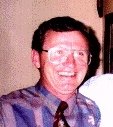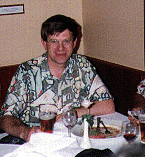|
|
||
|
|
Radschool Newsletter |
Vol 6 Page 5 |
|
|
||
|
Allan George |
||
|
|
||
|
Appy Land.
Allan George continues his memoirs of the life and times of an RAAF Radio Apprentice in the mid 60’s. He says:
“You may recall there was a hedge around the WRAAFery and around most of the Airman’s Mess at Laverton. Well that hedge had two purposes (uses): the official one, to constrain any hormones that had managed to rise above the level that was (supposedly) controlled by the bromide supplement secreted in our meals: the unofficial one, to entertain my fellow course mates. It did fail, I am led to believe (official lie), to meet its prime purpose, but it was very successful in entertaining my course mates.
They (Thomsen and Vereschildt in particular) took great delight in throwing me into, onto and if possible over the hedge whenever they got a chance. And whenever the opportunity arose at RMIT, they did something similar by throwing me up in blanket which of course would distract and amuse the other classes. They would see me appear, at regular intervals, laying horizontal outside the window ten feet above the ground.
One Saturday the DIs were bored (or they forgot to order the bus), so we were marched all the way over to Point Cook and back again. The DIs reveled in playing God by stopping the traffic on the Geelong Highway, next to Fleetwings, for us to go across (the over pass was not there then). Imagine trying to do that today, you’d be run down a million times. I can tell you, that was not one of our better Saturdays.
The OC’s duck pond came in for some close attention at various times, one of the blokes from 18 Course parked his go-cart in it, like wise several of the ‘thicks’ parked their cars in it. (John Butler parked his red Datsun Bluebird SSS there one night—tb) Some lads went there to do their supplementary exams in anatomy studies - having failed at Lowther Hall!!!!!!. (There has to be a story or two here—please tb)
For the Easter break we went to Ocean Grove and camped. This is where we all became experts at pitching tents, as was evident from Doug Pankhurst’s photo in last issue. For weeks beforehand we all looked forward to this break which was supposed to be a breather from our studies and a short reprieve from the regimentation of every day RAAF life. In fact for us it was a living hell as it gave the senior blokes uninterrupted access to us. We had to do all sorts of strange things, like find the cable holding Tasmania to the mainland. (The cable story is a myth, they’ve actually got 3 x 100hp Evinrudes down at Hobart to keep Tassie in place—tb) On another occasion we thought we were going to be forced to swim to Tasmania in the darkest of dark nights. At other times we went on camps to Little River (You Yangs) and Big River, (near Healesville). These were more fun, not the least because we did not have a senior course with us. On one camp at Little River we ambushed a group of ‘Frog-offs’ (ECS Cadets from Frognal) who were out on a night march.
Public transport to and from Laverton was not the best, with the old ‘once or twice a day’ motor-rail to and from Footscray station being our only train. Once you got to Footscray you were right as the suburban rail network kicked in there. None of us had cars, or were old enough to drive them, until third year when a few lucky blokes, mainly with help from home, managed to own something that burnt fuel and went under its own power. We had to make do with the best of a combination of hitchhiking and using the old rattler. At least three guys met their wives through hitching on Geelong Road, and as far as I know they are still married. I recall Nobby Smith and I walking from Western Oval at Footscray all the way back to Laverton one Saturday after a football match, trying to hitch a ride—without any success.
Whenever we went to town on a Saturday we would meet at the Wool Exchange Hotel (the closest pub to Spencer Street Station) just prior to closing in time to catch the last train ‘home’. One night, I remember, the round was ten gin squashes. I guess we must have drunk for effect (Is there another reason?? – tb) because it is the only time I can recall drinking gin squash—I’ve definitely never had one since.
A couple of the blokes for 20 Appy (no names—no pack drill) spent a night in the Russell Street over-night free accommodation complex after propositioning a couple of young ladies in Swanson Street. It mustn’t have done them any harm though, as one went on to be the top apprentice of his course and continues a very successful career in the RAAF today (that narrows it down a bit—tb). Blokes in my hut (451) were, Arnold Vereschildt, Dave Lugg, Paul Hewitt, Kevin Smith, Tony Neave, Trevor Connell, Jim Jones (hut NCO), Sam Houliston, Bruce Purcell, Trevor Lee, Garry Thomsen, Phil Laird, Linky Stroude, Bill Voolstra and Ray Moodie.
Sadly, Tony Neave died of cancer in 1995.
|
||
|
“I was playing golf the other day and hit a beautiful 185 metre drive, boy were the mob that run the mini golf pi$$ed off”. |
||
|
|
||
|
Nick Names.
In the late 60’s, early 70’s, anything and everything, including people, was hardly ever called by its proper name. If you had a mate who was named John, it just didn’t seem right to call him by his given name, you had to invent a “Nick-name” for him. Doesn’t seem to happen now as often as it did, perhaps the political correctness phase some years ago put an end to all that, if so, it’s a shame.
Prior to that nearly all blokes with red hair were called “Blue”, tall blokes were called “Shorty” or “Tiny”, fat blokes were either called “Bones” or “Porky-là”, you were called “Goat” if your first name was Bill, “Trackless” if your legs were a bit short and bald blokes were either called “Curley” or “Chrome-dome”.
Jim Legg at the 19 Appy reunion at Laverton in 1992. Jim was called "Foot" by his mates.
Likewise, there doesn’t seem to be the number of “characters” around that there used to be. At Richmond there were some wonderfully colourful characters; blokes like “Throbber” who it was said could weld together any two metals, except blue metal, but who loved the grape a bit too much, there was Butch and Meggsie who “owned’ the corner in the Airman’s Bar and hardly ever left the Base and “Hydraulic” who used to pinch the odd bit of stuff, and who it was said could lift anything.
All married blokes were called “Baggers” because they bought their lunch to work, and the married quarters where they lived was called the “Cabbage Patch”. Your bed was called a fart sack (to go to bed was to “hit the farter”), push bikes were called “treadlies”, the snack mobile was called a hungry van and its driver was called “hungry”, the Sergeants Mess was called the “Snake Pit” and the Officer’s Mess was called the “Pig Pen”. Even jobs were given names. Radio/Elec/Inst blokes were called queer traders, Sumpies/Framies were called black handers, Cooks were called “Bait layers” and Service Police were called “Spits”.
Do they still do that………...
|
||
|
Character we know reckons the only reason they have pilots in the Air Force is someone’s got to break the planes to give the ground crew blokes something to do…..At last, the secret’s out!!! |
||
|
|
||
|
The Globemaster.
We recently came across this photo of the old Douglas C124, otherwise known as the Globemaster. In the late 60’s, these giants of the air would regularly call into Richmond on their way to and from somewhere, for a load of fuel and a crew rest, and if you were on duty crew you got to have a look over them. Although they gave the impression of being an ungainly old war horse, with the flying characteristics of a brick, they must have been better than they looked because the USAF bought 448 of them.
Developed during 1947-49, they were first flown in 1950, and were in
service until 1974 when they were eventually ph
There was a little door on each side that opened into the wing, and you could walk out inside each wing to the inboard engines. The back end opened up with two side hinged doors, and they were used to carry all sorts of things—tanks, field guns, bulldozers, trucks, atomic weapons, or they could be fitted to carry 127 casualty stretchers or with seats to carry 200 fully equipped troops. By comparison, the C141A is 39ft high, and can carry 140 troops.
|
||
|
A woman is shopping in the local supermarket. She selects some milk, some eggs, a carton of juice, and a package of bacon. As she unloads her items at the cash register, a man standing behind her watches her place the four items on the belt and states with assurance - “You must be single.”
The woman looks at the four items on the belt and seeing nothing unusual about her selection says, “That’s right, but how on earth did you know that?”
He replies, “Because you’re ugly.” |
||
|
|
||
|
|
||
|
|
||
|
|
||

 There
were Dollars, Nerks, Camels, Soapies, Chuggers, Bengies, Fuji’s,
Pygmys, Bugsy’s, Spuds, Buckets, Black Jacks, heaps of Tommos, Mats,
Tobys, Basty-bums, Sams and lots and lots more.
There
were Dollars, Nerks, Camels, Soapies, Chuggers, Bengies, Fuji’s,
Pygmys, Bugsy’s, Spuds, Buckets, Black Jacks, heaps of Tommos, Mats,
Tobys, Basty-bums, Sams and lots and lots more.